By Joel G. Jorgensen – Nebraska Game and Parks Commission & Stephen J. Brenner – Audubon Great Plains
Late April through May is perhaps the most anticipated time of year for birders in Nebraska and elsewhere. After months of cold, slow, and uneventful winter birding, most birders relish the opportunity to witness the northward push of millions of birds dressed to the nines in fresh breeding plumage. The many migrant wood warblers of eastern North America usually highlight the roster of any spring outing. A dozen or more species, several of which are colorful gems, historically can be found on good days throughout May. However, sometimes the warbler migration does not live up to expectations and Spring 2024 seems to serve as a case study of a massive letdown. After a decent start in late April and early May, most migration seemed to evaporate by the middle of the May, a time when numbers of several species should be peaking. So, was Spring 2024 really that bad for warblers? Or are expectations in recent years clouded by idealizing highlights from a few exceptional but atypical spring migrations of the past? Here, we dive into the data from the Spring 2024 warbler migration in Nebraska in the hopes of trying to understand how it compares to previous years.
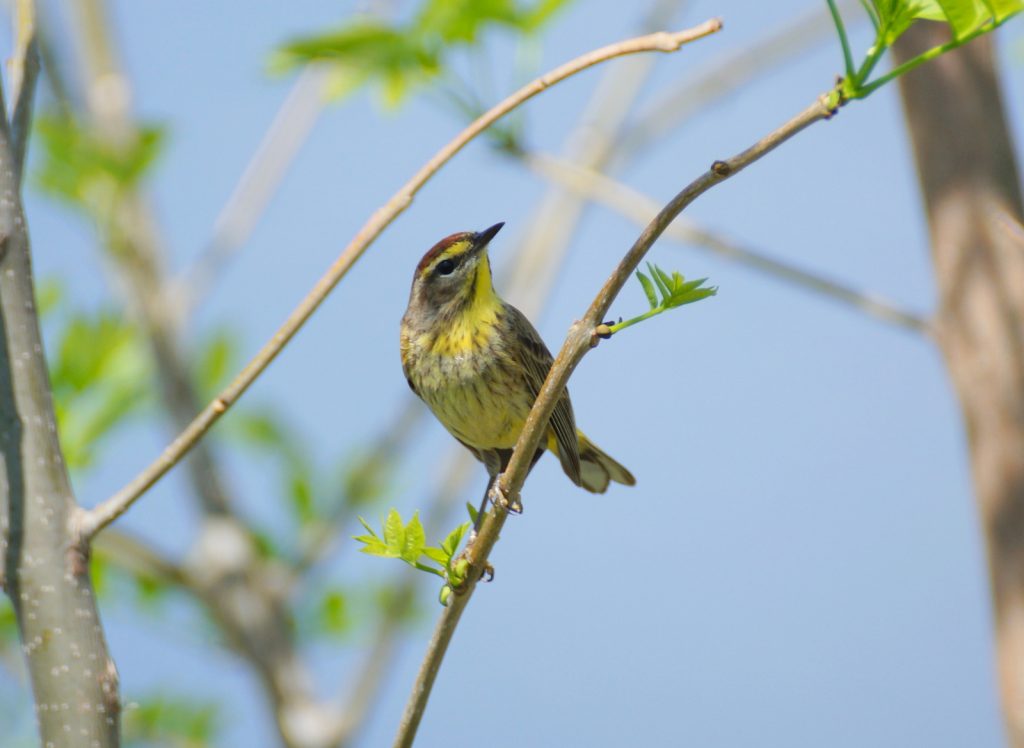
METHODS
We focused on rare to uncommon warbler species because they are usually reported as single individuals. Therefore, the pattern of individual reports across years is likely to provide a reasonable approximation of true temporal occurrence. These species are also sought after by birders each spring, reducing the possibility of under-reporting. We used data from eBird (ebird 2024) from Nebraska during 2020-2023 and 2024 to make comparisons about the overall number of reports of species between the two time periods. We then used eBird data from 2015-2023 and 2024 to make comparisons about the temporal occurrence of uncommon species between the two time periods. Specifically, we compare the 25th quartile, median and 75th quartile between the two time periods. The 25th percentile is the value at which 25% of the reports lie before that value, and 75% of the reports lie after that value. We eliminated duplicate sightings from the same location each day so that each hotspot/location had only one report of each species per day. We also eliminated reports west of the 100th Meridian because reports from western Nebraska often represent vagrants.
RESULTS
There were fewer reports for 14 out of 16 (87.5%) selected warbler species in 2024 compared to the average number of reports during 2020-23 in eastern Nebraska (Table 1). Nine of 16 (56%) warblers experienced a decline in the number of reports of 30% or more. Only two species (Blue-winged and Palm warbler) had more reports in 2024 compared to the average number of reports from 2020-23.

The median Julian day of reports for 6 out of 11 (55%) selected warbler species was earlier in 2024 compared to all data from 2015-23 (Table 2). The median Julian day of reports for 4 out of 11 (36%) warbler species was later in 2024 compared to all data from 2015-23. The median Julian day for one species (Mourning Warbler) was the same in 2024 compared to all data from 2015-23. The 25th quartile Julian day of reports for 7 out of 11 (64%) warbler species was earlier in 2024 compared to all data from 2015-23. The 25th quartile Julian day of reports for 3 out of 11 (27%) warbler species was later in 2024 compared to all data from 2015-23. The median Julian day for one species (Blackburnian Warbler) was the same in 2024 compared to all data from 2015-23. The 75th quartile Julian day of reports for 5 out of 11 (45%) warbler species was earlier in 2024 compared to all data from 2015-23. The 75th quartile Julian day of reports for 4 out of 11 (36%) warbler species was later in 2024 compared to all data from 2015-23. The 75th quartile Julian day for two species (Mourning and Canada warbler) was the same in 2024 compared to all data from 2015-23.
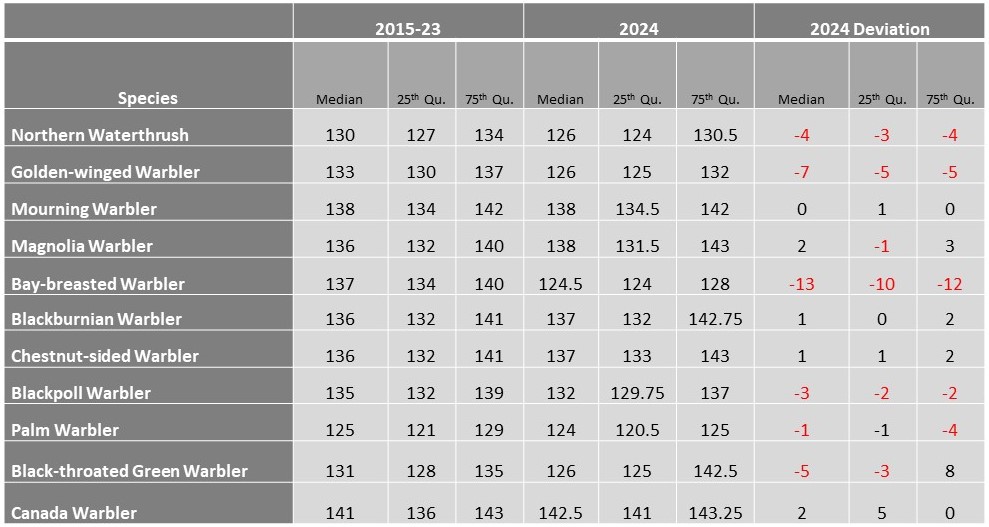
Histograms for three species comparing the temporal occurrence of reports generally shows that distribution of reports in 2024 are skewed left when compared to the averages of data from 2015-23. Visual inspection of histograms shows similar distributions between the two period during the early part of each period, but overall number of reports drop off sharply in 2024 during the latter portion of the period of interest. This pattern is most dramatic for Golden-winged Warbler, which was unreported after 11 May, which is before the median (13 May) during the period 2015-23.
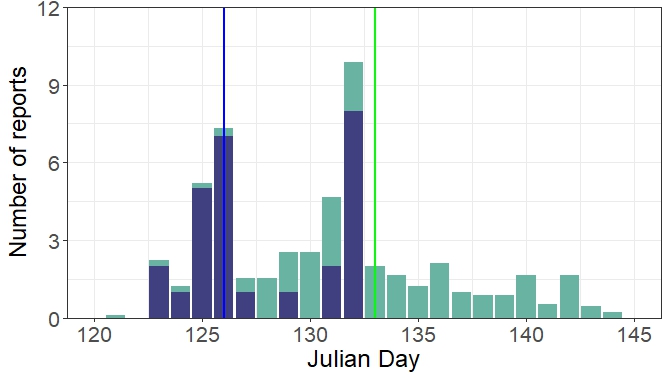
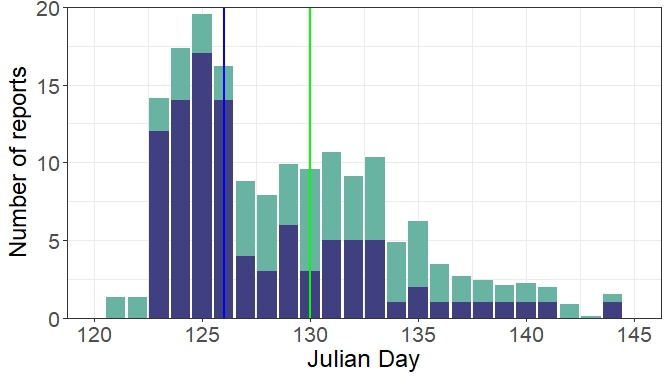
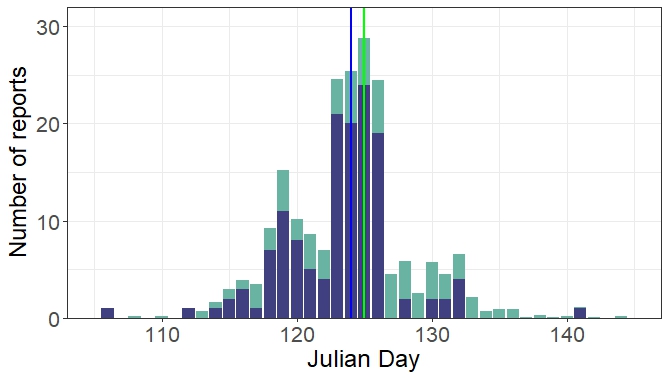
DISCUSSION
After reviewing the data, a few notable points emerge about Spring 2024 warbler migration in Nebraska. First, the overall number of reports for rare to uncommon warblers were, with only a couple exceptions, dramatically fewer in 2024 compared to the previous 4 years. Blue-winged Warbler was one of two species that showed better than average, but this is an exceptionally rare species and the 3 reports in 2024 is not only an anomaly, but the prior four-year average is also exceptionally small because of the small sample size and genuine rarity of the species. Palm Warbler is really the only species that truly was encountered in greater numbers in 2024 than the average number of reports during the period 2020-23.
The decline in reports for most species in 2024 comports with our observations, but the actual drop-off was sharper than we expected. Furthermore, our basic comparison does not account for birding activity or effort. eBird is a platform that has ever-increasing numbers of users, and this is not accounted for in our comparisons. Thus, actual decline in reports, when prorated with observer effort, may be even greater than what is reported here. One variable we cannot account for is whether birding activity substantially declined in middle to late May of 2024 as birders experienced diminishing returns in real-time.
Our temporal analysis shows that warbler migration was earlier and included a solid number of species but petered out in the middle May during a time when warbler migration, especially for later arriving species, is usually at its peak. Furthermore, even though reports for several species extended into the latter part of the month, reports were essentially at a trickle. After early May, there was no apparent second peak or discernable wave. Thus, if you didn’t get out in early May, you largely missed out on a solid diversity of warblers.
Reasons why warbler migration in 2024 was early and overall poor are not entirely clear. Bird migration is an incredibly complex process and simple answers are not only difficult to prove but also likely inadequate. However, one factor that cannot be discounted is that Nebraska and the larger region experienced a warm spring and tree and shrub “leaf out” was relatively early. The U.S. National Phenology Network (https://www.usanpn.org/data/maps/spring) showed that leaf out in Nebraska and points south was 20 days earlier than the long-term average. Previous research with large, long-term datasets across North America have established a relationship between earlier migration times for Neotropical migrants and warmer spring temperatures and advancing spring green-up (Marra et al. 2005, Mayor et al. 2017). Changes in leaf out and bird migration has all sorts of implications that we won’t get into here. However, if early leaf out is a phenomenon that becomes more regular in Nebraska, perhaps it is plausible that underwhelming warbler migrations in our area may become more frequent.
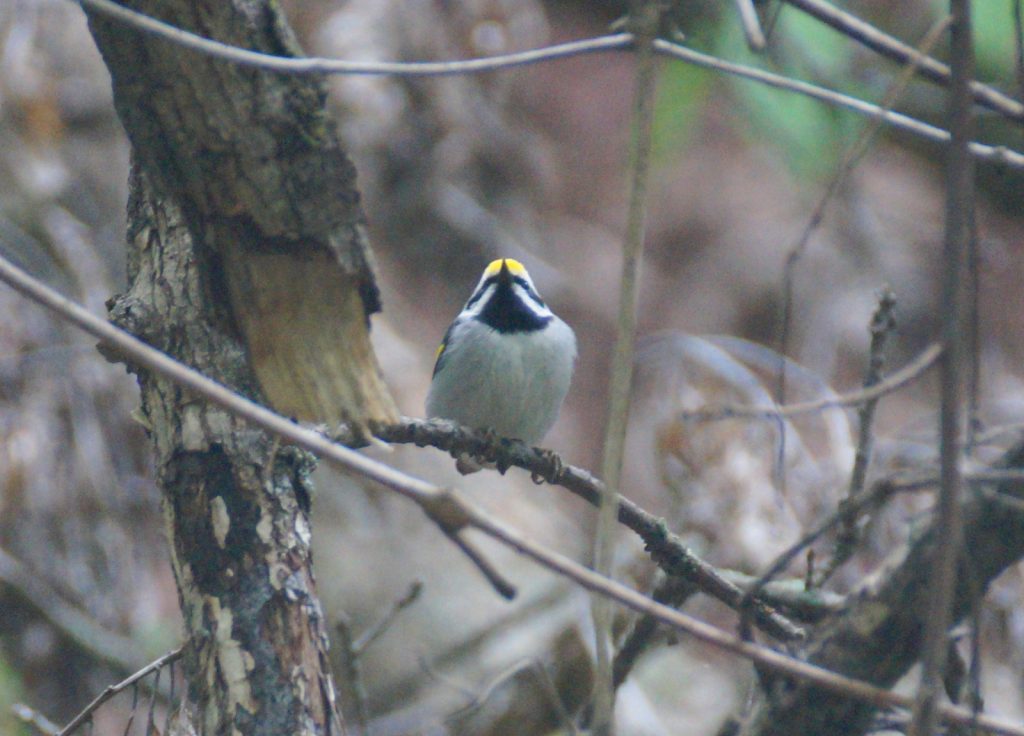
LITERATURE CITED
eBird. 2024. eBird: An online database of bird distribution and abundance [web application]. eBird, Cornell Lab of Ornithology, Ithaca, New York. Available: http://www.ebird.org. Accessed: June 2024.
Marra, P.P., C.M. Francis, R.S. Mulvihill, and F.R. Moore. 2005 The influence of climate on the timing and rate of spring bird migration.” Oecologia 142: 307-315.
Mayor, S.J., R.P. Guralnick, M.W. Tingley, J. Otegui, J.C. Withey, S.C. Elmendorf, M.E. Andrew, S. Leyk, I.S. Pearse, and D.C. Schneider. 2017. Increasing phenological asynchrony between spring green-up and arrival of migratory birds. Scientific reports 7: 1902.
Photos: Blackburnian Warbler by Stephen Brenner, Palm and Golden-winged Warbler by Joel Jorgensen.
Send comments or questions to joel.jorgensen@nebraska.gov